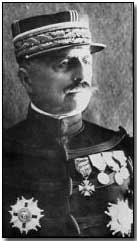Primary Documents - Franchet d'Esperey on the Vardar Offensive, 30 September 1918
 As the Allies increased
pressure upon German forces on the Western Front, so German troops were
hastily transferred from assisting Bulgaria, leaving
Bulgarian forces severely weakened and increasingly demoralised.
As the Allies increased
pressure upon German forces on the Western Front, so German troops were
hastily transferred from assisting Bulgaria, leaving
Bulgarian forces severely weakened and increasingly demoralised.
The moment was consequently considered ripe for a major Allied offensive against Bulgarian forces, newly aided by a Greek force donated by pro-Allied Prime Minister Eleutherios Venizelos. The Allied forces in the region were led by French General Franchet d'Esperey; he determined to launch the Vardar Offensive on 15 September 1918.
Allied success was immediate and impressive; within little over a week Bulgaria solicited for a ceasefire and on 29 September 1918 Bulgaria signed an armistice, thereby exiting from the war. In consequence of Bulgaria's military defeat King Ferdinand shortly afterwards abdicated.
Reproduced below is d'Esperey's official report summarising the offensive.
Click here to read British regional commander Sir George Milne's account. Click here to read a statement issued by Colonel Frantzis, Greek Military Attaché in London, on 29 September 1918. Click here to read d'Esperey's official telegram to Venizelos in praise of Greek troops. Click here to read Venizelos' own statement issued to local Greek commanders. Click here and here to read Milne's statements similarly lauding Greek efforts. Click here to read a statement issued by the Bulgarian government requesting a ceasefire. Click here to read the terms of the Bulgarian armistice. Click here to read the text of Tsar Ferdinand's abdication statement.
Franchet d'Esperey's Official Report on the Vardar Offensive, 30 September 1918
On September 15th, in the forenoon, two French divisions and one Serbian division, making an attack on the formidable mountain barrier formed by the Vetrenik, the Dobropolje, and the so-called Sokol, made a breach in the enemy front which was to bring about the falling-in of the front.
By this breach, which was gradually widened, the Serbian armies and the French and Greek troops supporting them went forward with untiring energy, in spite of the exceptional difficulties of the ground and of the desperate resistance of the enemy, towards their main objective - the region of Kavadar-Demir Kapoo.
They reached this region on September 22nd, cutting at one stroke the communications of the First Bulgarian army operating on the Vardar, and those of the 11th Bulgar-German army fighting to the north of Monastir. The French and Serbian troops rivalled each other in endurance, courage and self-sacrifice.
All the Allied forces gradually took part in the attack. On September 18th the British-Greek divisions, after stubborn fighting, captured the enemy positions of Doiran, retaining in this region very important forces. From September 21st the Italian, Greek and French troops of the Allied army of Monastir moved up.
On September 22nd the general pursuit commenced, and was carried out with splendid ardour and energy.
On September 23rd the Serbians crossed the Vardar towards Krivelak. On the 24th the French cavalry entered Prilep. On the 25th Ishtip was captured, as well as the formidable barrier of the Beles. The British opened up the road to Strumitza, which they entered on the 26th. On the same day the Serbians reached Kotchana and Veles, and the Italian, French and Greek troops were marching on Kicovo.
By the evening of the 26th the Bulgarians asked for a suspension of hostilities, and announced the dispatch of plenipotentiaries.
In the course of these glorious operations, which the hasty throwing in of German reinforcements was unable to prevent, the Allied armies captured a great number of prisoners and immense booty.
Allied air squadrons took a most active and efficient part in the battle, continually reporting to headquarters, bombarding and ceaselessly machine-gunning the enemy troops and convoys, sowing disorder among them and preventing them eluding our grasp.
Source: Source Records of the Great War, Vol. VI, ed. Charles F. Horne, National Alumni 1923
An Amiens Hut was a temporary structure of canvas on a frame used at British base camps.
- Did you know?
